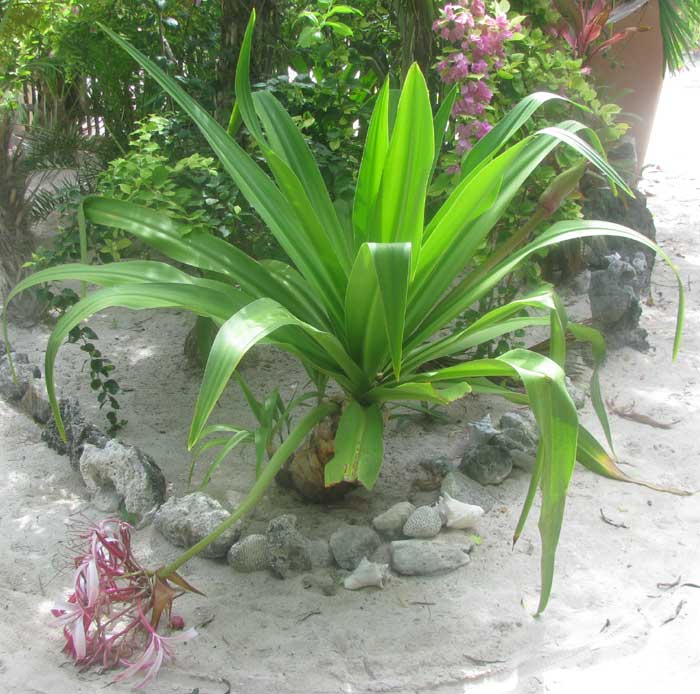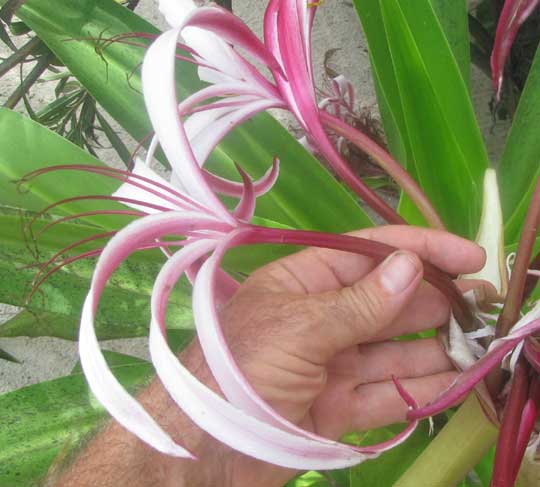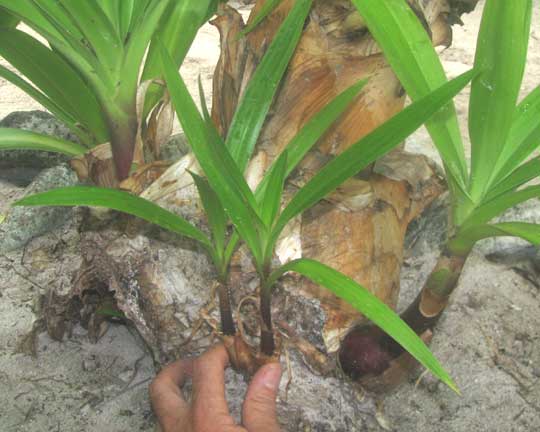Excerpts from Jim Conrad's
Naturalist Newsletter

from the July 3, 2011 Newsletter issued from Mayan Beach Garden Inn 20 kms north of Mahahual; Caribbean coastal beach and mangroves, ~N18.89°, ~W87.64°, Quintana Roo state, MÉXICO
QUEEN EMMA'S WEEK
This has been the very week when a certain Amaryllus- like plant has reached its peak of flowering, as shown above. The plant, growing at the base of my stairs, stands about five feet tall (1.5m). The bent-down stem, or scape, bearing the flower cluster is about 3.5 feet long (>1m). You can gauge the flowers' size better below:

This species, native to tropical Southeast Asia, is commonly grown in Mexico's hot lowlands. It goes by several English names, including Spider Lily (a name applied to many different species), Crinum Lily, Stately Lily and Queen Emma Lily. All these names are misleading, since the plant isn't a member of the Lily Family, but rather belongs to the Amaryllis Family. It's CRINUM AUGUSTUM 'Queen Emma', the "'Queen Emma'" appended to the binomial being the cultivar name.
In other words, in Southeast Asia someone once collected wild plants of Crinum augustum from which later horticulturalists developed plants with certain "more desirable" features -- maybe plants with bigger, redder flowers. That cultivar, with a slightly altered genetic makeup, was named after Queen Emma.
Queen Emma, by the way, was Emma Rooke (1836-1885) of Hawaii, who was queen consort of King Kamehameha IV (1833-1863). Queen Emma, they say, was particularly fond of the plant, even though it wasn't native to Hawaii. The plant does grow there wild now, though, as it does in many tropical regions.
In fact, Marcia says that after Hurricane Dean in 2007, when all the garden plants here had been knocked down, swept away, or buried beneath sand, after four days the very Queen Emma shown in my photographs began issuing green blades up through the sand, and she's been grateful ever since to that plant for such an encouraging gesture. Marcia says that after Dean she saw lots of the plant's bulbs washed up along the beach, and I see plants thriving at the edge of the mangroves where apparently they were deposited by Dean. Therefore, in our area this beautiful, alien plant seems to be spread by hurricanes.
One reason Queen Emma's bulbs might withstand such rough treatment is their sheer size -- some bulbs weighing up to 20 pounds (9kg). Healthy offshoots arising from our plant's massive bulb are seen below:

The bulbs are so substantial that it would be nice if they were edible. However, I read that they're poisonous, though in Asia people apply slices of roasted bulbs to their skin to reduce rheumatic pain. They also use leaf juices for earache.